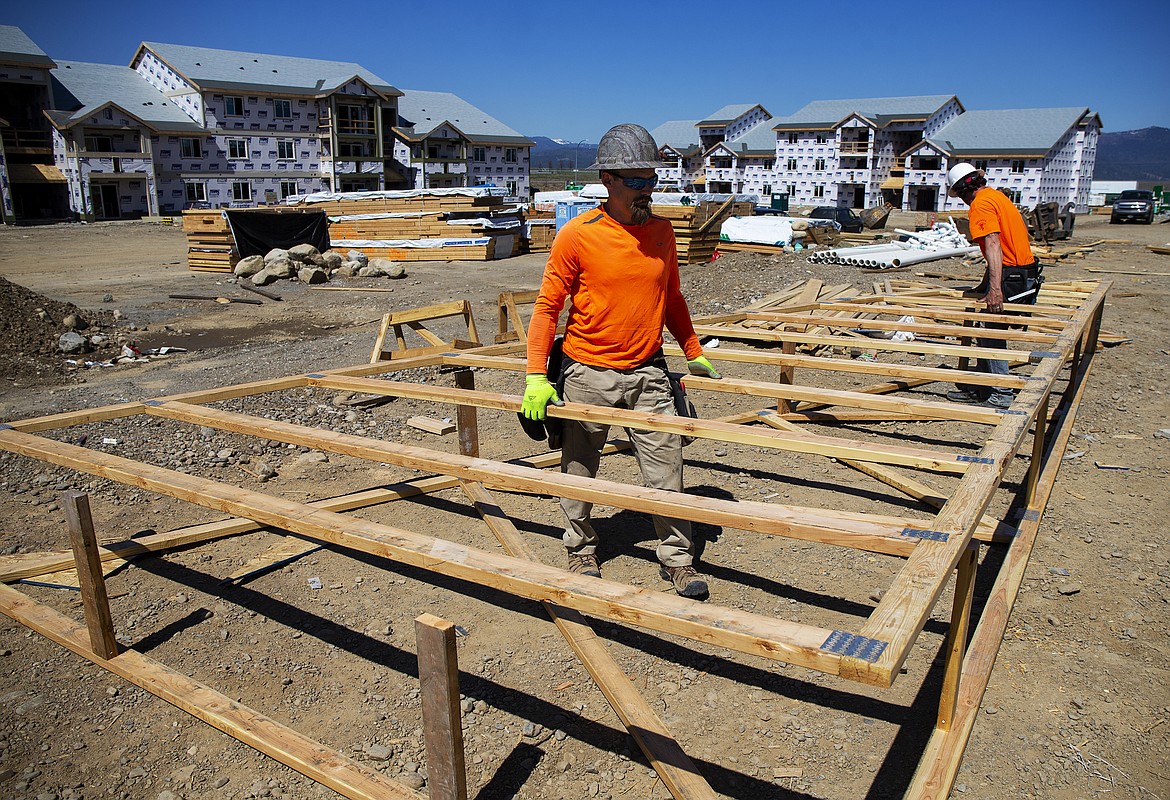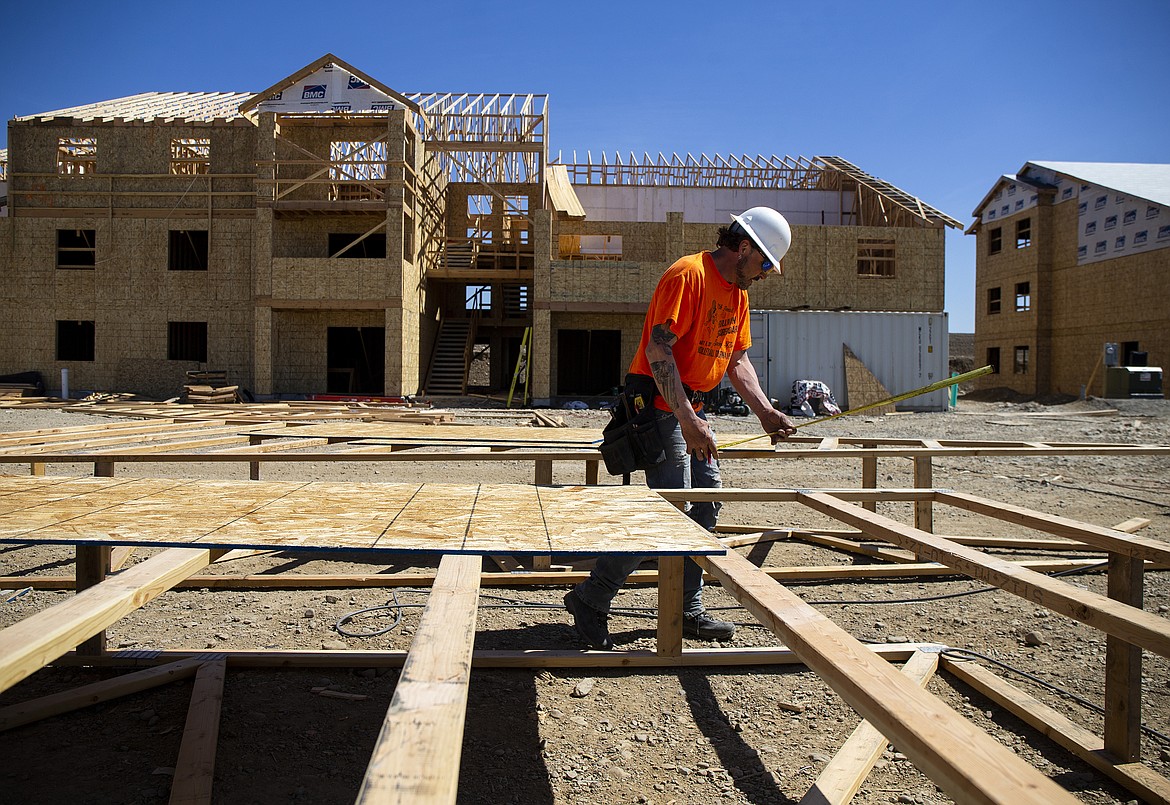Building boom returns; cities try to plan for growth
Post Falls City Council meeting regular Bob Flowers has become cross-eyed from trying to keep track of all the subdivision requests in the past year.
"I know Post Falls will grow, but I'd like to know if it's planned growth," said Flowers, a long-time Post Falls resident who recently asked for the city's growth statistics based on the plethora of proposals.
"I believe that things are being run through so fast these days that not a lot of planning goes into it. It concerns me that it's all going to catch up with us, and I'd like to know if somebody is driving the boat rather than it being on auto pilot."
Flowers' instincts on rapid growth are confirmed by the numbers.
The city recorded nearly 300 acres and more than 600 lots in 21 single-family residential subdivisions in 2017 and an additional 25 acres and 84 lots in two subdivisions as of last month in 2018. Most of the growth is on the city's north side toward the Rathdrum Prairie.
"We are currently permitting approximately 60 single-family homes per month," said Jon Manley, Post Falls' planning manager.
With multi-family residential, 426 units were approved in the past year and a half.
City planners and real estate industry professionals say there continues to be a demand for housing options.
Between 2014 and 2016, 583 multi-family units were constructed — and most are occupied at this time.
In addition to the projects that have been approved, there are seven subdivision proposals consisting of 209 lots making their way through the public hearing process now.
"We may permit somewhere in a range of 800 to 1,000 residential units this year," said Manley, adding that most other years have been between 300 and 500.
'Scary' forecast
Manley said Post Falls' population is expected to be about 37,500 by the end of the year. But the prediction that has caught many people's attention is the Kootenai Metropolitan Planning Organization's estimate of 105,491 in 2040 based on a 4.8 percent growth rate.
"The verdict is out on whether Post Falls meets KMPO's forecast ultimately, but Post Falls may grow at a rate of more than 7 percent for 2018," Manley said.
Flowers calls the forecast "scary."
"That's not the Post Falls I want," he said.
Flowers said the future is what keeps him coming to city council meetings that generally draw sparse attendance.
"There are too many things going on to not be at the meetings," he said. "Things are changing way too fast."
Manley said the growth spurt has stretched the city's personnel resources, but he believes the city's water, wastewater and transportation plans have adequately planned for current and future growth.
Post Falls police Chief Pat Knight said he's developing a plan to present to the city council to hire officers in the future to keep public safety a priority amid growth.
Post Falls Mayor Ron Jacobson, a former city council member, has served with the city for nearly 27 years and has seen multiple economic swings. He said last year's single-family residential permit activity resembled the boom year of 2006 as more than 350 permits were issued for each year. This year's number — 123 through the end of March, the latest monthly stat available — is on pace to surpass those previous growth spurts.
Jacobson said there are widespread opinions on growth, but he believes it's good if it's sustainable. He believes the city has dealt with the explosive growth well.
"We have ample, but not unlimited, water supply and wastewater capacity," he said. "We have updated master plans for both water and wastewater and we monitor annexation requests to ensure we do not deplete this capacity. While land may be annexed and development plans approved, if water and wastewater capacity is not available, building permits will not be issued. While the growth we have experienced has been high, it has been tolerable."
There are also updated master plans for schools and transportation to keep pace with growth, Jacobson said.
Jacobson said the city has worked with the Idaho Transportation Department on the widening of its Highway 41 starting in 2020 and the future intersection update of that highway at Interstate 90.
He said he's most concerned about the recent influx of multi-family developments despite the real estate industry's assessment that vacancy rates are low.
"I am concerned whether the number of new multi-family units being built will be sustainable," he said, adding that city staff is creating a more detailed report on such growth that indicates the specific number of units rather than projects and buildings. "We recognize that it is important to know exactly how many units this involves."
Growth all over
Other cities that share the Rathdrum Prairie — Hayden and Rathdrum — are also growing faster than typical years. Further, rural Kootenai County is proposed to have one of the largest developments planners have seen since before the recession.
English Point Heights is a proposed 155-lot gated "agrihood" community on 95 acres — 20 of those a farm — at the corner of Lancaster and Hayden Lake roads.
"We haven't seen anything with this intensity for at least a decade," said Vlad Finkel, a county planner.
Hayden has 12 subdivisions that were either recently improved or are under construction.
"We have 449 single-family residential lots and 96 multi-family residential units that are in some stage of permitting or development," said Connie Krueger, Hayden's economic development director, adding that the numbers do not include the available inventory on the market.
Krueger said Hayden's biggest challenge is funding public services such as public safety and addressing infrastructure needs such as roads and sewer.
"Up until the past 25 years or so, Hayden was primarily a rural community," she said. "We are now a suburban community in the top 20 of Idaho cities in terms of population, but with a tax levy rate of that rural community that we were not so long ago.
"With growth, development and diversification, we will engage in community planning and will also need to address this problem with our tax base. Both will be done to properly fund services and infrastructure and to preserve and enhance those things that we love Hayden for."
Krueger said the challenge is not insurmountable, but needs to be addressed. With a healthy economy, private developers fund infrastructure related to their project and a growing tax base addresses public needs.
"With so many of our businesses linked to services, the introduction of more businesses and people leads to diversification … ," she said. "As a community, we then experience the introduction of new ideas and technologies. All of these items are important to a healthy, balanced Hayden community."
Rathdrum issued 164 residential building permits in 2017 — more than any of the previous four years and comparable to the boom years of 2004 to 2006 — and had already issued 51 in 2018 as of last month.
Rathdrum has 12 subdivisions that are being built.
The only subdivision that's been approved this year is Legacy Place, a 6-acre, 14-lot project next to North Idaho STEM Charter Academy. No subdivision proposals are making their way through the approval process, but the city is in conversations with a developer on a 13-acre site next to Majestic Park.
"We are working on planning so that it will be positive growth for the community," City Administrator Leon Duce said. "We want to keep the type of atmosphere that brought people to Rathdrum to begin with."
Ripple effects
Despite being landlocked by Post Falls, Hayden and the lake, Coeur d'Alene still has some space to be developed.
A 500-lot subdivision on the northeast corner of Coeur d’Alene Place in the Ramsey Road corridor is scheduled to be completed within the next eight years.
Coeur d'Alene issued 335 single-family permits in 2017 (the most since 2007) and, as of last month, 69 this year. It has more than 20 total residential developments under construction.
Sam Wolkenhauer, a regional economist with the Idaho Department of Labor, is often asked the question of where all the people moving here are finding work.
"This job growth has been mostly incremental across a wide swathe of industries," he said, adding that has been the biggest factor, not new large businesses moving or relocating here. "Most of the industries in Kootenai County have grown in the last year through incremental expansion to keep up with orders."
From 2012 to 2017 jobs increased by 16 percent in Kootenai County from 58,400 to 67,800, according to IDOL. The change outpaced the national growth rate of 7 percent.
Kootenai County's population increased 10 percent during the five-year stretch to 157,000.
Growth, he said, has a ripple effect.
"Given how many new residents are moving to our area, we should expect demand for housing, services and financial and real estate services to continue to be very strong this year."
Jacobson said that, while he'd like to see a lower level of annual growth, he can't control the market.
"I've heard it said that Post Falls and our entire area have been discovered," he said. "It was discovered many years ago and the economy has fueled the growth we are experiencing. I personally do not want to see Post Falls grow at the level some have forecasted, but I also don't believe we can flip a switch to stop growth."





